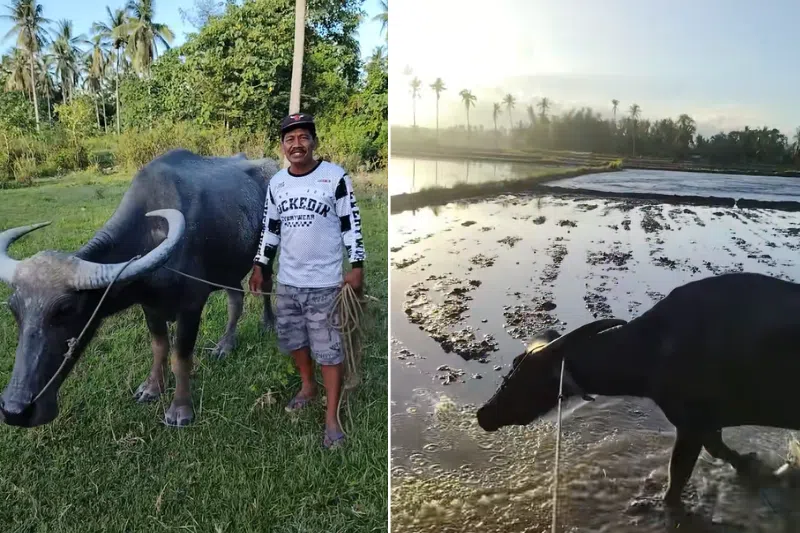Viral TikTok clip saves ‘senior citizen’ water buffalo from slaughter in rural Philippines
Sign up now: Get ST's newsletters delivered to your inbox

The carabao – which for 32 years had dutifully ploughed its master’s field – had been slated for slaughter, till a viral TikTok post gave it a lifeline.
PHOTOS: JEZREEL BEONCIO/TIKTOK
Follow topic:
For over 32 years, a carabao – a domesticated water buffalo – ploughed a rice field and hauled heavy loads for its master. When it couldn’t anymore, it was marked for slaughter.
Fortunately, in the social media age when word spreads far and wide at the speed of a thought, the ageing animal found an unlikely lifeline – on TikTok, of all places.
Mr Jezreel Beoncio, 21, said in a post on TikTok on Nov 12 that he was asked to haul the carabao from a farm in Bongabong town, in central Philippines, to a slaughterhouse.
But when he saw the animal, he thought about rescuing it instead.
He said that for 32 years, the carabao had been a workhorse: ploughing a rice field, and moving people, produce and supplies.
He said the owner told him he would not have been able to send five children to school had it not been for this carabao.
But it had grown old, weak, sickly and practically useless. For its owner, it had only one use left: as meat.
In his Nov 12 post that has been seen by close to 3 million users, Mr Beoncio said he saw the owner weep at having to part with his workhorse.
He said the owner told him: “I love this carabao, but I am not a wealthy man.”
Mr Beoncio said he would have purchased the carabao himself, but he was just a student and did not have the money.
He said he just wanted to raise awareness about how little appreciation carabaos get in the Philippines, even after many years of faithful and productive service.
So he was surprised to see his post go viral. Strangers started offering to send money to save the carabao, even though Mr Beoncio told The Straits times the post never intended to raise funds.
He eventually managed to raise some 50,000 pesos (S$1,100) and purchase the carabao from its owner just a day before it was slated to be slaughtered.
Someone also offered to adopt the carabao, but she later backed out.
“Maybe she’s just too busy, and I understand that,” Mr Beoncio said.
He said he is keeping the carabao for now, but he is still hoping someone will step up to adopt the animal.
“I can keep him, but I’m just a student, and I can’t cover all his needs,” he said.
Sharing Mr Beoncio’s story on its Facebook page, the group Bataan Animal Welfare said, by human standards, the carabao would already be considered a “senior citizen” who deserves “respect, protection and much-needed rest”.
“But because it’s just an ‘animal’, some still think it’s normal that he ends up at a slaughterhouse to be sold by the kilo,” it said.
“This is not right. This is not humane,” the group added. “This is not fair for a life that served faithfully till its strength failed him.”
Carabaos are widely regarded as indispensable in Philippine agriculture.
Known as “living tractors”, they plough and harrow rice fields and often serve as a primary means of transportation in rural areas.
Their heavy frame and steady temperament make them well-suited for the demands of farm work that, in many places, remains largely manual.


